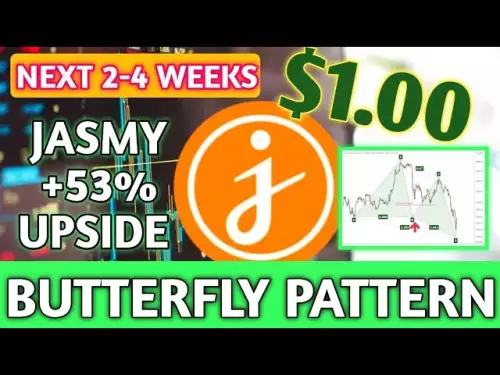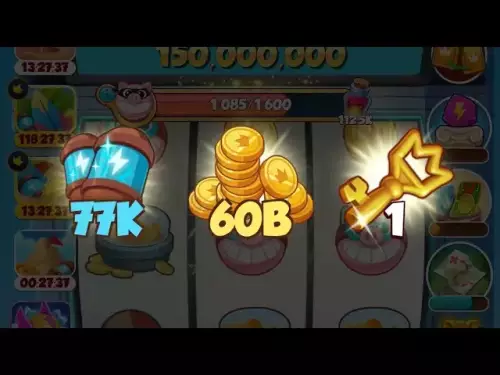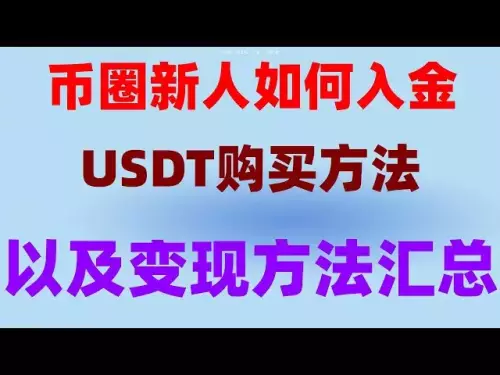-
 Bitcoin
Bitcoin $109600
-3.34% -
 Ethereum
Ethereum $4395
-7.86% -
 XRP
XRP $2.879
-5.44% -
 Tether USDt
Tether USDt $1.000
0.03% -
 BNB
BNB $848.8
-3.38% -
 Solana
Solana $188.0
-11.51% -
 USDC
USDC $0.9999
0.01% -
 TRON
TRON $0.3436
-4.13% -
 Dogecoin
Dogecoin $0.2103
-9.93% -
 Cardano
Cardano $0.8390
-8.95% -
 Chainlink
Chainlink $23.25
-11.27% -
 Hyperliquid
Hyperliquid $43.76
-7.03% -
 Ethena USDe
Ethena USDe $1.001
0.02% -
 Stellar
Stellar $0.3868
-5.66% -
 Sui
Sui $3.358
-9.71% -
 Bitcoin Cash
Bitcoin Cash $544.1
-7.20% -
 Avalanche
Avalanche $23.39
-9.28% -
 Hedera
Hedera $0.2327
-6.97% -
 UNUS SED LEO
UNUS SED LEO $9.562
-0.20% -
 Litecoin
Litecoin $109.7
-7.26% -
 Toncoin
Toncoin $3.158
-4.78% -
 Shiba Inu
Shiba Inu $0.00001212
-7.47% -
 Uniswap
Uniswap $9.787
-10.28% -
 Polkadot
Polkadot $3.777
-8.51% -
 Dai
Dai $1.000
0.00% -
 Cronos
Cronos $0.1572
-1.63% -
 Bitget Token
Bitget Token $4.491
-3.47% -
 Aave
Aave $326.8
-6.05% -
 Monero
Monero $265.7
-4.62% -
 Ethena
Ethena $0.6304
-8.90%
What is the significance of a sudden spike in the MAVOL indicator?
A sudden spike in the MAVOL indicator signals heightened trading volume, often preceding significant price moves and revealing strong market conviction or potential reversals.
Aug 05, 2025 at 11:15 am
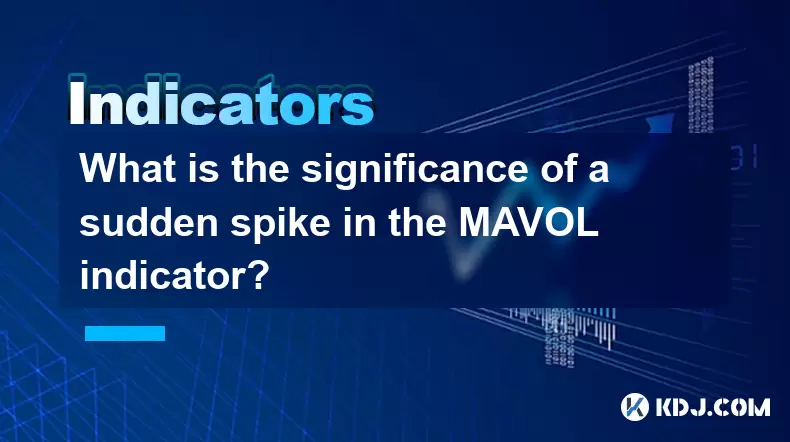
Understanding the MAVOL Indicator in Cryptocurrency Trading
The MAVOL indicator, short for Moving Average of Volume, is a technical analysis tool used by cryptocurrency traders to assess the average trading volume over a specific period. Unlike price-based indicators, MAVOL focuses solely on volume, offering insights into market participation and potential shifts in momentum. It calculates the average volume over a defined number of periods—commonly 5, 10, or 20 days—and plots it as a line on the chart. A sudden spike in this indicator often signals a meaningful change in market behavior. When volume increases sharply compared to recent averages, it suggests heightened interest, which could precede significant price movements. This makes the MAVOL a critical tool for identifying early signs of accumulation, distribution, or breakout scenarios.
Interpreting a Sudden Spike in MAVOL
A sudden spike in the MAVOL indicator reflects a substantial increase in trading volume relative to the historical average. This surge can occur during major news events, such as regulatory announcements, exchange listings, or macroeconomic developments affecting the crypto market. The spike indicates that a large number of market participants are actively buying or selling, which may point to a shift in sentiment. For instance, if the price of a cryptocurrency is rising alongside a spike in MAVOL, it suggests strong buying pressure and potential continuation of the uptrend. Conversely, if the price is falling with high volume, it may indicate panic selling or a bearish breakout. Traders use this information to validate the strength of a price move—high volume adds credibility to the trend.
Correlation Between MAVOL Spikes and Price Action
The relationship between MAVOL spikes and price movements is essential for confirming market signals. A price breakout supported by a spike in volume is considered more reliable than one occurring on low volume. To analyze this correlation effectively, traders often overlay the MAVOL indicator on the same chart as the price. They look for divergence or convergence between the two. For example:
- A price increase accompanied by a rising MAVOL confirms bullish momentum.
- A price drop with a spiking MAVOL validates bearish momentum.
- A price breakout without a corresponding volume spike may indicate a false move or lack of conviction.
Using candlestick patterns in conjunction with MAVOL enhances accuracy. A green candle with a long body and high volume on the MAVOL chart strengthens the case for a bullish reversal. Similarly, a red candle with extreme volume suggests strong bearish control. This multi-layered analysis helps traders avoid whipsaws and focus on high-probability setups.
How to Set Up and Monitor MAVOL on Trading Platforms
To utilize the MAVOL indicator effectively, traders must configure it correctly on their preferred trading platform. Most platforms, including TradingView, Binance, and MetaTrader, support volume moving averages. The following steps outline how to set up and interpret MAVOL:
- Open the chart of the desired cryptocurrency pair.
- Click on the “Indicators” button and search for “Volume” or “Volume MA.”
- Select the moving average type (simple is most common) and set the period (e.g., 10).
- Adjust the color and thickness for visibility—green for the MAVOL line is standard.
- Observe real-time changes and compare current volume bars to the MAVOL line.
When the volume bar extends significantly above the MAVOL line, a spike is occurring. Traders should also enable alerts to receive notifications when volume exceeds a certain threshold. Custom scripts can be used to automate detection of spikes, such as setting a condition where volume is 200% above the 10-day MAVOL. This proactive monitoring allows for timely entry or exit decisions.
Common Misinterpretations of MAVOL Spikes
Despite its usefulness, the MAVOL indicator can be misread if not analyzed in context. One common mistake is assuming that every spike leads to a sustained trend. In reality, volume spikes can occur during short-term liquidations or whale trades that do not reflect broader market sentiment. For example, a large sell order executed on a single exchange might trigger a volume spike without initiating a long-term downtrend. Another error is ignoring the price level at which the spike occurs. A spike at a strong resistance zone may indicate rejection, while one at support could signal accumulation. Traders must also consider the timeframe—spikes on lower timeframes (e.g., 5-minute charts) may be noise, whereas those on daily or weekly charts carry more weight. Combining MAVOL with other tools like RSI, MACD, or on-chain metrics improves interpretation accuracy.
Strategic Responses to MAVOL Spikes
When a sudden spike in MAVOL is detected, traders can take several strategic actions depending on their position and market context. For those using a breakout strategy, a spike confirms the validity of the breakout and justifies entering a trade. For swing traders, it may signal an opportunity to add to a position or tighten stop-loss orders. Day traders might use the spike to initiate momentum trades, riding the volume surge for short-term gains. Risk management remains crucial—spikes can precede reversals, especially after prolonged trends. Therefore, placing stop-loss orders just below key support or above resistance helps mitigate downside risk. Traders should also avoid chasing price after a large spike, as exhaustion gaps or overbought conditions may follow.
Frequently Asked Questions
What timeframes are best for observing MAVOL spikes?
The daily and 4-hour charts are most effective for identifying meaningful MAVOL spikes. These timeframes filter out market noise and reflect institutional-level activity. Lower timeframes like 5 or 15 minutes may show frequent spikes due to algorithmic trading, making them less reliable for trend confirmation.
Can a MAVOL spike occur without a price change?
Yes, a volume spike can happen with minimal price movement, especially during consolidation phases. This is known as a "volume climax" and may indicate accumulation or distribution. For example, a coin trading in a tight range with a sudden volume surge could mean large players are building positions before a breakout.
How does the MAVOL differ from the OBV indicator?
While both measure volume, MAVOL calculates the average volume over time, whereas On-Balance Volume (OBV) accumulates volume based on price direction. OBV adds volume on up days and subtracts on down days, creating a running total. MAVOL is simpler and focuses on magnitude, while OBV emphasizes directional flow.
Is a higher MAVOL period setting more reliable?
Not necessarily. A 20-period MAVOL smooths out noise but may lag during fast-moving markets. A 5-period MAVOL reacts quickly but can generate false signals. Traders often use multiple MAVOL lines (e.g., 5 and 20) together to identify crossovers and confirm volatility shifts.
Disclaimer:info@kdj.com
The information provided is not trading advice. kdj.com does not assume any responsibility for any investments made based on the information provided in this article. Cryptocurrencies are highly volatile and it is highly recommended that you invest with caution after thorough research!
If you believe that the content used on this website infringes your copyright, please contact us immediately (info@kdj.com) and we will delete it promptly.
- Heritage Distilling's Token Deal: A Bold Balance Sheet Strategy
- 2025-08-26 06:45:14
- Coinbase Hack, Solana Shenanigans, and Wallet Woes: What's a Crypto OG to Do?
- 2025-08-26 06:45:14
- Bitcoin, Institutional Adoption, and Volatility: A 2025 Perspective
- 2025-08-26 08:05:14
- MAGACOIN, Ethereum, and XRP Growth: What's the Buzz?
- 2025-08-26 08:30:13
- ETHZilla's Bold Moves: Share Buyback and Ethereum Holdings Under Scrutiny
- 2025-08-26 08:05:14
- Cardano, ADA Price, and the ETH L2 Meme Coin Frenzy: What's Next?
- 2025-08-26 08:50:13
Related knowledge
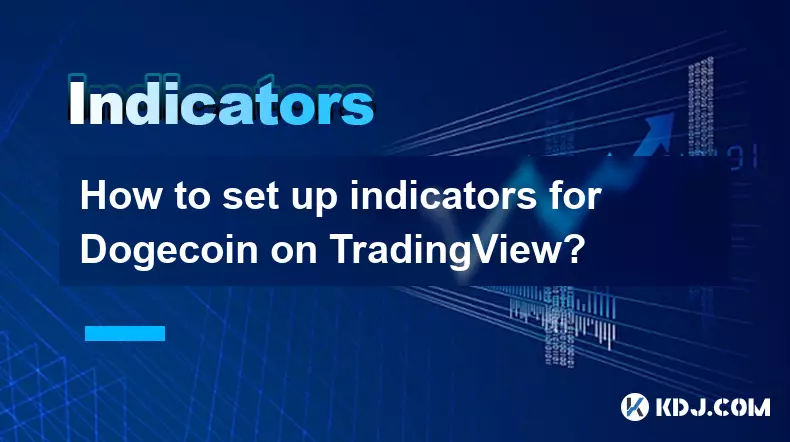
How to set up indicators for Dogecoin on TradingView?
Aug 25,2025 at 04:23pm
Understanding Dogecoin and TradingView1. Dogecoin, initially created as a meme-based cryptocurrency, has evolved into a widely traded digital asset. I...

What does it mean when the +DI and -DI cross frequently in the DMI indicator but the ADX is flattening?
Aug 11,2025 at 03:15am
Understanding the DMI Indicator ComponentsThe Directional Movement Index (DMI) is a technical analysis tool composed of three lines: the +DI (Positive...

What does the sudden appearance of a "dark cloud cover" candlestick pattern during an uptrend indicate?
Aug 13,2025 at 11:35am
Understanding the 'Dark Cloud Cover' Candlestick PatternThe dark cloud cover is a bearish reversal pattern in technical analysis that typically appear...

What does it mean when the moving average, MACD, and RSI all send buy signals simultaneously?
Aug 11,2025 at 01:42pm
Understanding the Convergence of Technical IndicatorsWhen the moving average, MACD, and RSI all generate buy signals at the same time, traders interpr...

What does it mean when both the KDJ indicator and the RSI show overbought signals simultaneously?
Aug 13,2025 at 11:35am
Understanding the KDJ Indicator in Cryptocurrency TradingThe KDJ indicator is a momentum oscillator derived from the Stochastic Oscillator, widely use...

What does it mean when the price is trading above the SAR indicator but the red dots are densely packed?
Aug 09,2025 at 11:49pm
Understanding the SAR Indicator and Its Visual SignalsThe SAR (Parabolic Stop and Reverse) indicator is a technical analysis tool used primarily to de...

How to set up indicators for Dogecoin on TradingView?
Aug 25,2025 at 04:23pm
Understanding Dogecoin and TradingView1. Dogecoin, initially created as a meme-based cryptocurrency, has evolved into a widely traded digital asset. I...

What does it mean when the +DI and -DI cross frequently in the DMI indicator but the ADX is flattening?
Aug 11,2025 at 03:15am
Understanding the DMI Indicator ComponentsThe Directional Movement Index (DMI) is a technical analysis tool composed of three lines: the +DI (Positive...

What does the sudden appearance of a "dark cloud cover" candlestick pattern during an uptrend indicate?
Aug 13,2025 at 11:35am
Understanding the 'Dark Cloud Cover' Candlestick PatternThe dark cloud cover is a bearish reversal pattern in technical analysis that typically appear...

What does it mean when the moving average, MACD, and RSI all send buy signals simultaneously?
Aug 11,2025 at 01:42pm
Understanding the Convergence of Technical IndicatorsWhen the moving average, MACD, and RSI all generate buy signals at the same time, traders interpr...

What does it mean when both the KDJ indicator and the RSI show overbought signals simultaneously?
Aug 13,2025 at 11:35am
Understanding the KDJ Indicator in Cryptocurrency TradingThe KDJ indicator is a momentum oscillator derived from the Stochastic Oscillator, widely use...

What does it mean when the price is trading above the SAR indicator but the red dots are densely packed?
Aug 09,2025 at 11:49pm
Understanding the SAR Indicator and Its Visual SignalsThe SAR (Parabolic Stop and Reverse) indicator is a technical analysis tool used primarily to de...
See all articles





















